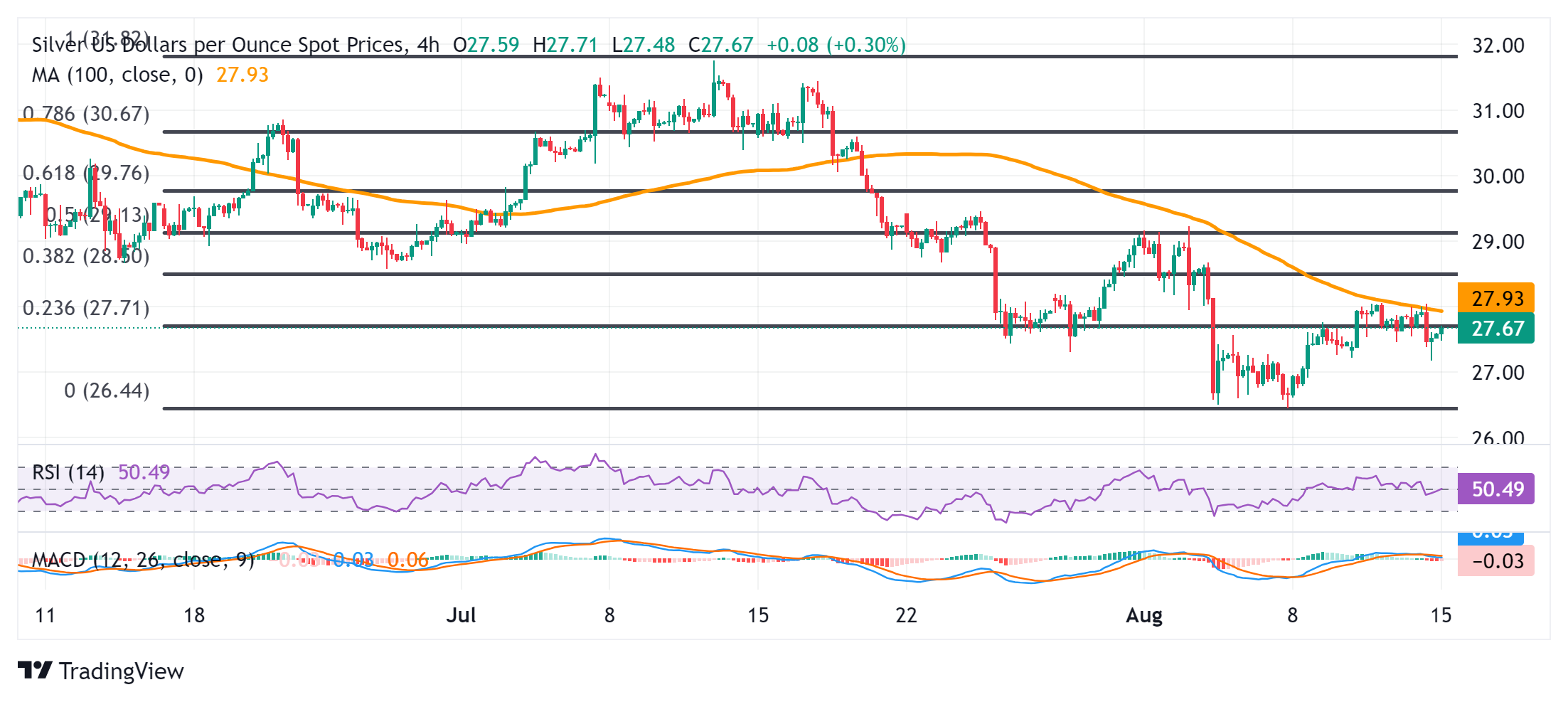Silver Price Prediction: XAG/USD might continue to face stiff resistance near $28.00
- Silver attracts some buying on Thursday and recovers further from the weekly low.
- The technical setup warrants caution before positioning for any further move up.
- A sustained move beyond the $28.00 mark is needed to negate the negative bias.
Silver (XAG/USD) gains some positive traction during the Asian session on Thursday and builds on the overnight bounce from the $27.20-$27.15 region, or the weekly low. The white metal currently trades around the $27.70 area, up 0.40% for the day, and for now, seems to have snapped a two-day losing streak.
From a technical perspective, this week's repeated failures near the 100-period Simple Moving Average (SMA) hurdle on the 4-hour chart, currently pegged near the $28.00 mark, warrant some caution for bullish traders. Furthermore, neutral oscillators on the said chart make it prudent to wait for strong follow-through buying before positioning for an extension of the recent bounce from the $26.45 area, or over a three-month low touched last week.
The XAG/USD might then climb to 38.2% Fibo. level, around the $28.45 region, before aiming to reclaim the $29.00 mark. The latter coincides with the 50% Fibo. level and is followed by the monthly swing high, around the $29.20 area, which if cleared decisively will be seen as a fresh trigger for bullish traders. The subsequent move up could lift the white metal further towards the $29.70 resistance en route to the $30.00 psychological mark.
On the flip side, the overnight swing low, around the $27.20-$27.15 region, now seems to protect the immediate downside ahead of the $27.00 round figure. Some follow-through selling might expose the multi-month low, around the $26.45 area, below which the XAG/USD could slide to the $26.00 mark. The downward trajectory could extend further towards the next relevant support near the $25.60 horizontal zone en route to the $25.00 psychological mark.
Silver 4-hour chart

Silver FAQs
Silver is a precious metal highly traded among investors. It has been historically used as a store of value and a medium of exchange. Although less popular than Gold, traders may turn to Silver to diversify their investment portfolio, for its intrinsic value or as a potential hedge during high-inflation periods. Investors can buy physical Silver, in coins or in bars, or trade it through vehicles such as Exchange Traded Funds, which track its price on international markets.
Silver prices can move due to a wide range of factors. Geopolitical instability or fears of a deep recession can make Silver price escalate due to its safe-haven status, although to a lesser extent than Gold's. As a yieldless asset, Silver tends to rise with lower interest rates. Its moves also depend on how the US Dollar (USD) behaves as the asset is priced in dollars (XAG/USD). A strong Dollar tends to keep the price of Silver at bay, whereas a weaker Dollar is likely to propel prices up. Other factors such as investment demand, mining supply – Silver is much more abundant than Gold – and recycling rates can also affect prices.
Silver is widely used in industry, particularly in sectors such as electronics or solar energy, as it has one of the highest electric conductivity of all metals – more than Copper and Gold. A surge in demand can increase prices, while a decline tends to lower them. Dynamics in the US, Chinese and Indian economies can also contribute to price swings: for the US and particularly China, their big industrial sectors use Silver in various processes; in India, consumers’ demand for the precious metal for jewellery also plays a key role in setting prices.
Silver prices tend to follow Gold's moves. When Gold prices rise, Silver typically follows suit, as their status as safe-haven assets is similar. The Gold/Silver ratio, which shows the number of ounces of Silver needed to equal the value of one ounce of Gold, may help to determine the relative valuation between both metals. Some investors may consider a high ratio as an indicator that Silver is undervalued, or Gold is overvalued. On the contrary, a low ratio might suggest that Gold is undervalued relative to Silver.

